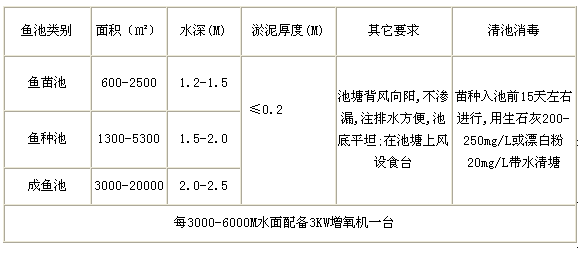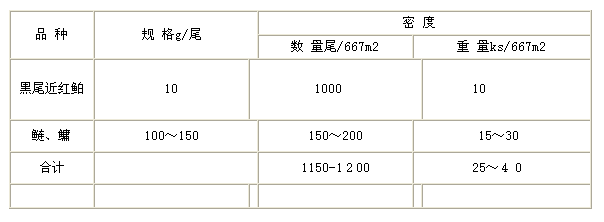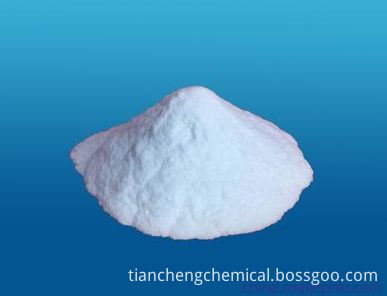1, site selection
The water sources are abundant, the water quality is fresh, the water intake and drainage are convenient, and there are no pollution sources such as chemical plants that pose a threat to the water quality within 3 km around the aquaculture waters. The power supply is stable and reliable, and the traffic is convenient.
2, aquaculture water
In addition to complying with fishery regulations, aquaculture pond water has a transparency of 25cm to 30cm, and fish ponds and food ponds have a water clarity of 30cm. PH: 7-8.5.
3. Pond conditions Pond conditions are shown in Table 1. 
4, seed cultivation
The fry yolk sac basically disappeared, the larvae were inflated, they could swim flatly, and they had the ability to swim against the water. The fish was not black.
Fish quality
Normal body shape, complete fins, scales, smooth body surface, strong physique, swimming activity, neat specifications, disease-free without injury.
Seed cultivation and management
7 days to 8 days before the fertilization of fry, 200kg to 300kg/667 kilos of basic fertilizer, where the application of organic fertilizer should be regarded as pond fat, a full application, base fertilizer is mainly decomposed manure. Can be used 1% to 2% lime or bleaching powder 10mg/L disinfection.
Water injection: 7 days after fertilization, add new water filtered by dense mesh to make the water depth of the cultivation pond reach 0.5m.
Fish species are stocked in mid-May. Choose sunny days. When the breeze is in the upwind position, soak the container with fish fry (such as oxygen bags) in the fish pond water for about 30 minutes so that the temperature difference between the inside and outside of the container (bag) does not exceed 3°C. According to every 667? Water surface stocking size is 1 cm black tail red seedlings 80,000 to 100,000 tails.
Feeding management
Feeding. Every day, Quanchipang splashes the soy milk 2 times to 3 times, and each 10,000 3 cm fish species needs 6kg to 8kg of soybeans.
top dressing. Depending on the water quality and the growth status of fish species, it is flexible and the total amount of top dressing is 100 kg to 200 kg/667 。.
Water injection. Each time about 15 cm of water is injected, a total of 3 to 4 injections of water are added in the entire period, and finally the maximum water level is added.
Daily management. Three times a day to visit the pool, so that "three check" and "three times." In the early, middle and late nights, check for floating heads, changes in water quality, fish activity and growth;
Pulling nets and refining. The fry was reared for 20 days to 25 days and the length was about 3cm. Before going out of the pond, you should choose a sunny day. When you are not floating, pull the net to make a total of 2 to 3 times. For the first time, due to the tenderness of the fish, the nets were put back into the fish ponds immediately after they were moderately dense. Pull the second net every other day, and concentrate the fish species for 10 to 20 minutes. In the event of a encounter with wild fish or wild fish, use a fish sieve to filter out. Pull the third net every other day.
5, fish species cultivation
Fertilization, water injection: Fertilizer fry 7 days to 8 days before the start, base fertilizer 200kg ~ 300kg / 667?, Where the application of organic fertilizer should be considered pond fat, a full foot, base fertilizer to compost manure. Can be used 1% to 2% lime or bleaching powder 10mg/L disinfection.
The water was added to the pool water 0.8m 3 to 4 days after fertilization.
Restocking is based on the specifications of the pond, and it is stocked with the number of fish. In general, the stocking size of each 667 ? in June and the middle of the month is approximately 2500-4000 tails of summer flowers with a total length of 3cm to 3.5cm. After 7 days, 1,000 squid and squid with a total length of 2.5cm to 3cm can be raised.
Feeding management
Feeding. In the early stage, every day, about 10,000 black tails are near red. The pre-cast soybean cake (pastry cake) is poured into the water and splashed. Mid- and late-phase pellet feeds are supplemented with natural baits.
Tame food
After 8cm in summer, the species begins to taming. Before each feeding, a specific sound is struck with a fixed vessel, and the fish is then fed to the food table with broken pellet feed to form a conditional reflex. The feed is fed 5 to 7 times, 30 minutes each time, for 7 days. About tame food, so that the formation of fish caught in the water after eating habits into normal feeding.
Feeding method
The speed of the feed should be determined according to the status of the fish. If feeding is intense, increase the feeding area and increase the speed. According to the rhythm of “slow, fast and slowâ€, feed for 30 minutes to 40 minutes each time. .
Feeding bait to achieve "four settings, four look" to achieve "uniform, good, enough." In the general growing season, the amount of daily feeds accounts for 4% to 6% of the total amount of fish. The use of feed should meet the requirements of GB13078 and NY5072-2002.
Daily management visits the pool three times a day, so that "three surveys" and "three services." In the early, middle and late nights, check for floating heads, changes in water quality, fish activity and growth;
Pulling nets and refining. The fry was reared for 20 days to 25 days and the length was about 3cm. Before going out of the pond, you should choose a sunny day. When you are not floating, pull the net to make a total of 2 to 3 times. For the first time, due to the tenderness of the fish, the nets were put back into the fish ponds immediately after they were moderately dense. Pull the second net every other day, and concentrate the fish species for 10 to 20 minutes. In the event of a encounter with wild fish or wild fish, use a fish sieve to filter out. Pull the third net every other day.
6, food fish breeding
Pond master
Source of fingerlings
Fertilizers produced from elite farms that own or have a seed production license.
Fish quality.
Fish species stocking
Restocking time
When stocking above 10°C, stocks of black-tailed red-tailed fish should be stocked.
Stocking
See Table 2 for stocking specifications and densities of pond grass carp.
Table 2 Pond rearing red stocking specifications and density 
Fish disinfection
Fish should be disinfected before stocking.
Feed and feeding
Feed requirements
The content of crude protein in the formulated feed was 32%, and the safety limit of compound feed should comply with the provisions of NY 5072.
Tame food.
After the stocks are purchased, they should start tame food: after each feeding, knock a specific sound with a fixed vessel, and then feed the fish to the food table with broken pellet feed to form a conditional reflex. Feed it 5 times a day. 7 times, 30 minutes each time, after 7 days of domestication, so that the fish formed on the surface of the water to catch the habit of feeding after feeding
According to the weather, water temperature and fish feeding conditions, the amount of feeding and the number of feedings were properly adjusted. When the water temperature is lower than 18°C, the daily feed is 1% to 3% of the fish's body weight and it is fed twice daily. When the water temperature is more than 20°C, the daily feed is 3% to 5% of the fish's body weight. 3 to 5 times.
Feeding method
The speed of the feed should be determined according to the status of the fish. If feeding is intense, increase the feeding area and increase the speed. According to the rhythm of “slow, fast and slowâ€, feed for 30 minutes to 40 minutes each time. .
Daily management
Patrol Pool
After the fish species are released, they will be patrolled once a day in the morning and evening to observe the changes in water quality, fish activities and feeding conditions, adjust the amount of feed to be fed in a timely manner, remove impurities in the pool, and keep the pool clean and sanitary; find dead fish and diseased fish and pick them up promptly. Buried, fill in production records.
Water quality management
As the season and water temperature are different, new water is added to adjust the water level, usually once every half month and once every week in the high temperature season, each time adding water 15cm to 30cm. In the high temperature season, open the aerator for 1 hour to 2 hours at noon on sunny days.
7, disease prevention
Prevention of fish disease generally has the following measures:
a) Careful production operations to avoid fish injuries;
b) Strict disinfection of fry and fingerlings before entering the pool. Commonly used fish disinfectant drugs and methods include:
1) salt 1% to 3%, bath for 5 minutes to 10 minutes;
2) Potassium permanganate lOmg/L~20mg/L, bath for 15 minutes to 20 minutes;
3) Povidone iodine 30 mg/L, bath for 15 minutes to 20 minutes.
The above three kinds of drugs can be used in production;
c) Disinfect quicklime on the pool water.
d) remove dead fish in time and bury it deeply;
e) Fishing gear used in sick fish ponds should be immersed in water;
f) Immunization of fish species before stocking.
treatment
Black tail near red Common diseases and treatment methods are shown in Table 3.
Table 3 Common diseases of black tail near red and treatment methods 
Drug use and drug withdrawal period should comply with NY 5071
Hubei Xiaogan Hanjiang Famous Fish Breeding Farm
Hubei Xiaogan Hanjiang Famous Fish Breeding Farm mainly conducts the breeding of famous elite fish species, scientific experiments in fisheries, introduction and demonstration of new varieties, and promotion. The base covers an area of ​​500 acres. It is equipped with nearly 100 acres of aquatic product breeding breeding ponds and steel framed cement shed pools, special power supply lines and generator sets, a horizontal 2-ton steam boiler to ensure greenhouse heating, and 120 meters deep wells to ensure the purity The groundwater supply, as well as a complete set of equipment for breeding fish.
The company has 2 senior engineers, 5 engineers, 8 assistant engineers, and 15 professional and technical personnel. Academician Cao Wenxuan, a member of the Chinese Academy of Sciences Institute of Aquatic Sciences, is invited to work as a technical advisor, and has close technical cooperation and exchanges with universities such as Huazhong Agricultural University and Xiaogan University. A series of trials have been carried out on the breeding of European oysters, the breeding of American oysters, and the southern oystercatcher; the breeding, breeding, and cultivation of larvae, bigmouth bream, and stingray have been carried out; the paddy field and cage culture experiments have been conducted. The soft-shelled turtle breeding, as well as the breeding of fish and fish bone fish fry and the application of muddy breeding techniques and other famous fish development. He took the lead in the domestic breeding of Bream's Drosophila and paddlefish, and achieved remarkable results. He achieved a leading level in the domestic fisheries industry.
The company now mainly engages in the breeding and breeding of high-quality fish such as paddlefish, river eels, koi, and scallops. It annually produces 2 million spatula species, 1 million eriobotrya species, and Koi seedlings. 5 million tails, 2 million tails of Acrocephalus.
Silicon dioxide nano particles are known as Nano Silica, it is also called Silica nano-particles. It is used particularly in the Biomedical researches. This nano silica is expected to be very much stable and to have very low level of toxicity. It is also used as concrete or cement admixture with aim to improve concrete pressure strength.

Nano Silica,Silica Nano-Particles,Concrete Nano Silica,Nano Silica SP30
Shandong Tiancheng Chemical Co., Ltd. , https://www.akdchemical.nl